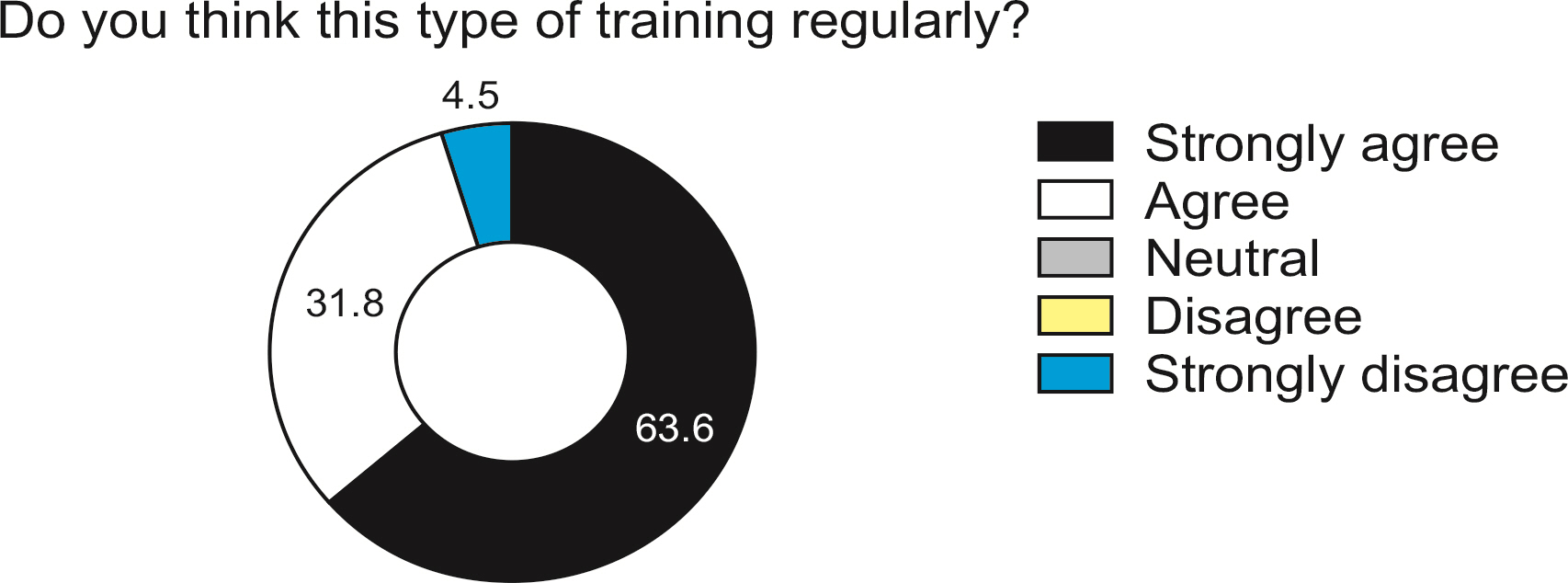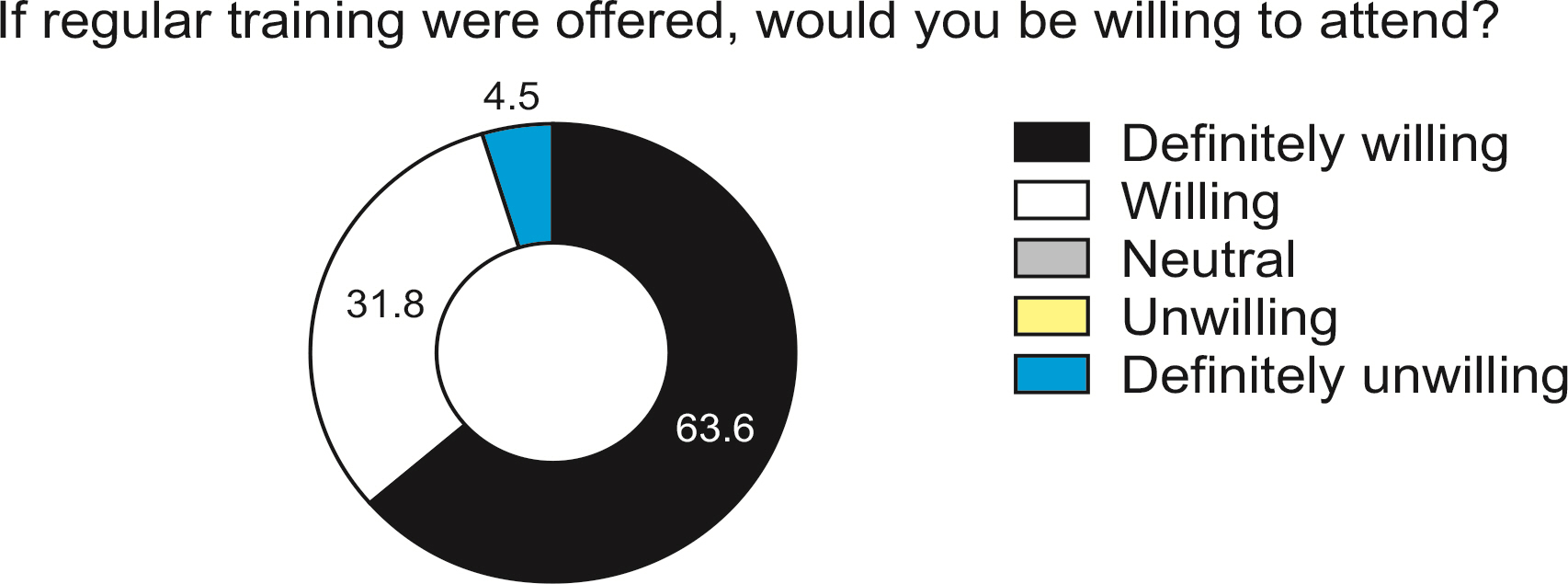J Korean Acad Oral Health.
2023 Dec;47(4):214-221. 10.11149/jkaoh.2023.47.4.214.
Community-based visiting healthcare personnels’ capacity in elderly oral health care and the effectiveness of group oral health education: a pilot study
- Affiliations
-
- 1Department of Preventive and Public Health Dentistry, Seoul National University School of Dentistry, Seoul, Korea
- 2Dental Research Institute, Seoul National University School of Dentistry, Seoul, Korea
- KMID: 2550176
- DOI: http://doi.org/10.11149/jkaoh.2023.47.4.214
Abstract
Objectives
This study is an effectiveness evaluation study of an oral health education program conducted on 30 visiting nurses who participated in the “CHAT-DONG” project in a district of Seoul, Korea. The primary objective of this study is to obtain basic data for the development of an oral healthcare education program for visiting nurses.
Methods
To evaluate the effectiveness of the educational program comprising lecture and small group practice training, oral health knowledge, beliefs, awareness, self-efficacy, and oral health status assessment capabilities were assessed before and after the training, using Google online surveys. Finally, data from 22 participants were used for analysis.
Results
Overall oral health knowledge improved after the training, however, specific oral disease knowledge was low. There were no significant changes in oral health beliefs and awareness, but there was a significant increase in self-efficacy. The ability to assess oral health status improved a little, however, the ability to express specific oral health conditions was low. This may be owing to the limitations of a one-time training and the inexperience and unfamiliarity of the participants. The participating nurses were highly satisfied with the training program and expressed a strong desire for regular and ongoing training.
Conclusions
This study highlights the necessity for systematic and sustained training programs for healthcare personnel, including visiting nurses, to provide effective oral healthcare to older adults. Furthermore, the development of such training programs should consider the demographic characteristics of the target population and their level of prior knowledge and experience when designing, implementing, and evaluating training programs.
Keyword
Figure
Reference
-
References
1. Ministry of Health and Welfare & Korean Health Promotion Foundation. 2023. Guide book for 2023 community integrated health promotion services: Home visiting service. Ministry of Health and Welfare;Sejong:2. Lee G, Yang SJ, Yoo EH. 2018; Past, present, and future of home visiting healthcare services basedon public health centers in Korea. J Korean Public Health Nurse. 32:5–18.3. Seoul Metropolitan Government. Guidebook for home visiting nurse. Seoul. [Internet]. Available from https://news.seoul.go.kr/welfare/archives/47156. cited 2023 Nov 1.4. Baek HC, Moon JH. 2016; The development of home-visiting nurses'professional competencies. J Korean Acad Soc Home Care Nurs. 23:233–242.5. Jin BH, Paik HR, Park JA, Lee JY, Lee GR, Han S. 2020. Evaluation of oral health care status and development of oral health care assessments tools and guidelines: based on the caregivers at elderly care facilities. Seoul National University R&DB Foundation;Seoul:6. 2021. Global strategy on oral health. WHO;Geneva:7. Bandura A. 1977; Self-efficacy: toward a unifying theory of behavioral change. Psychol Rev. 84:191–215. DOI: 10.1037/0033-295X.84.2.191. PMID: 847061. PMCID: PMC4010856. PMID: ccb9da1c287e4fc889803ed90e077385.8. Launder W, Watson R, Topping K, Holland K, Johnson M, Porter M, et al. 2008; An evalaution of fitness for practice curricula; self-efficacy, support and self-reported competence in preregistration student nurses and midwives. J Clin Nurs. 17:1858–1867. DOI: 10.1111/j.1365-2702.2007.02223.x. PMID: 18578760.9. Jho MY. 2014; Effects of core fundamental nursing skills education on self-efficacy, clinical competence and practice satisfaction in nursing students. J Korean Acad Fundam Nurs. 21:292–301. DOI: 10.7739/jkafn.2014.21.3.292.10. Office of Personnel Management. Competencies. 2023 [Internet]. Available from https://ofm.wa.gov/state-human-resources/workforce-data-and-planning/workforce-planning/competenciesURL. Cited 2023 Dec 1.11. Kim MH. 2009; Roles of visiting nurses defined based on long-term care insurance regulation for the elderly. J Korean Acad Public Health Nurs. 23:232–250.12. Nam HK, Cho KS. 2015; Job analysis of the nurses who work in customized visiting health care services using DACUM technique. J Muscle Joint Health. 22:205–218. DOI: 10.5953/JMJH.2015.22.3.205.13. Tsukada S, Ito K, Stegaroiu R, Shibata S, Ohuchi A. 2017; An oral health and function screening tool for nursing personnel of long-term care facilities to identify the need for dentist referral without preliminary training. Gerodontology. 34:232–239. DOI: 10.1111/ger.12255. PMID: 28066920.14. Chalmers JM, Pearson A. 2005; A systematic review of oral health assessment by nurses and carers for residents with dementia in residential care facilities. Spec Care Dentist. 25:227–233. DOI: 10.1111/j.1754-4505.2005.tb01654.x. PMID: 16454098.
- Full Text Links
- Actions
-
Cited
- CITED
-
- Close
- Share
- Similar articles
-
- Preliminary study for the development of a visiting oral health care intervention program for the elderly based on community healthcare
- Development of the Model for Community-based Health Care Program for Premature Infants and Family
- Effect of Professional Oral Healthcare Program on the Oral Status of Elderly Residents in Long-Term Care Facilities
- The Development and Effect of a Storytelling Based Diabetes Education Material: Focus on Rural Elderly with Diabetes
- Exploration of the experience of caregivers for oral health care for the elderly in long-term care facilities: based on the grounded theory






